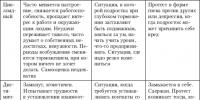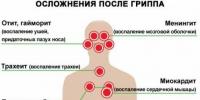Lagrange multiplier method. Economic meaning of Lagrange multipliers
| Parameter name | Meaning |
| Article topic: | Lagrange method. |
| Rubric (thematic category) | Mathematics |
Finding a polynomial means determining the values of its coefficient ![]() . To do this, using the interpolation condition, you can form a system of linear algebraic equations(SLAU).
. To do this, using the interpolation condition, you can form a system of linear algebraic equations(SLAU).

The determinant of this SLAE is usually called the Vandermonde determinant. The Vandermonde determinant is not equal to zero for for , that is, in the case when there are no matching nodes in the lookup table. However, it can be argued that the SLAE has a solution and this solution is unique. Having solved the SLAE and determined the unknown coefficients ![]() you can construct an interpolation polynomial.
you can construct an interpolation polynomial.
A polynomial that satisfies the interpolation conditions, when interpolated by the Lagrange method, is constructed in the form of a linear combination of polynomials of the nth degree:
Polynomials are usually called basic polynomials. In order to Lagrange polynomial satisfies the interpolation conditions, it is extremely important that the following conditions are satisfied for its basis polynomials:
 For
For ![]() .
.
If these conditions are met, then for any we have:
Moreover, the fulfillment of the specified conditions for the basis polynomials means that the interpolation conditions are also satisfied.
Let us determine the type of basis polynomials based on the restrictions imposed on them.
1st condition: at .
2nd condition: .
Finally, for the basis polynomial we can write:
Then, substituting the resulting expression for the basis polynomials into the original polynomial, we obtain the final form of the Lagrange polynomial:
A particular form of the Lagrange polynomial at is usually called the linear interpolation formula:
 .
.
The Lagrange polynomial taken at is usually called the quadratic interpolation formula:
Lagrange method. - concept and types. Classification and features of the category "Lagrange method." 2017, 2018.
Linear remote controls.
For a solution of this type, we will consider two methods: the Lagrange method and the Bernoulli method. Consider a homogeneous differential equation. This equation is with separable variables. The solution of the equation is General... . - Linear control systems, homogeneous and heterogeneous. The concept of general decision. Lagrange method of variation of production constants. Definition. A control system is called homogeneous if the function can be represented as the relationship between its arguments. Example.
homogeneous fth measurements if Examples: 1) - 1st order of homogeneity. 2) - 2nd order of homogeneity.
- Lecture 8. Application of partial derivatives: extremum problems. Lagrange method.
Extremum problems have
great importance in economic calculations. This is the calculation, for example, of maximum income, profit, minimum costs depending on several variables: resources, production assets, etc. The theory of finding extrema of functions... .
- T.2.3. DE of higher orders. Equation in total differentials. T.2.4. Linear differential equations of the second order with constant coefficients. Lagrange method.
3. 2. 1. DE with separable variables S.R.
The classical approach to solving the problem provides a system of equations (necessary conditions) that must be satisfied by the point that provides the function with a local extremum on the set of points that satisfy the restrictions (for a convex programming problem, the found point will also be the global extremum point).
Let us assume that at a point function (1) has a local conditional extremum and the rank of the matrix is equal to . Then the necessary conditions will be written in the form:
there is a Lagrange function;
– Lagrange multipliers.
There are also sufficient conditions under which the solution of the system of equations (3) determines the extremum point of the function. This question is resolved based on the study of the sign of the second differential of the Lagrange function. However, sufficient conditions are mainly of theoretical interest.
You can specify the following procedure for solving problem (1), (2) using the Lagrange multiplier method:
1) compose the Lagrange function (4);
2) find the partial derivatives of the Lagrange function with respect to all variables and equate them
zero. Thus, a system (3) will be obtained, consisting of equations. Solve the resulting system (if this turns out to be possible!) and thus find all the stationary points of the Lagrange function; 3) from stationary points taken without coordinates, select points at which the function has conditional local extrema in the presence of restrictions (2). This choice is made, for example, using sufficient conditions local extremum
. Often the study is simplified if specific conditions of the problem are used.
Example of problem solution
The task
The company produces two types of goods in quantities and . The useful cost function is determined by the relation. The prices of these goods in the market are equal and accordingly.
Determine at what output volumes maximum profit is achieved and what it is equal to if total costs do not exceed
Having trouble understanding the progress of a decision? The website offers a service Solving problems using methods of optimal solutions to order
The solution of the problem
Economic and mathematical model of the problem
Profit function:
Cost restrictions:
We get the following economic and mathematical model:
Moreover, according to the meaning of the task
Lagrange multiplier method
Let's compose the Lagrange function:
We find the 1st order partial derivatives:
Let's create and solve a system of equations:
Since then
Maximum profit:
Answer
An example of solving a quadratic convex programming problem using a graphical method is given.
Solving a linear problem by graphical method
Considered graphic method problem solving linear programming(ZLP) with two variables. An example of the task is given detailed description constructing a drawing and finding a solution.
Wilson's inventory management model
Using the example of solving the problem, the basic model of inventory management (Wilson model) is considered. The following model indicators were calculated: optimal size order quantities, annual holding costs, delivery intervals and ordering point.
Direct Cost Ratio Matrix and Input-Output Matrix
Using the example of solving a problem, Leontiev's intersectoral model is considered. The calculation of the matrix of coefficients of direct material costs, the matrix “input-output”, the matrix of coefficients of indirect costs, vectors of final consumption and gross output is shown.
LAGRANGE METHOD
A method for reducing a quadratic form to a sum of squares, indicated in 1759 by J. Lagrange. Let it be given
from variables x 0 , x 1 ,..., x n.
with coefficients from the field k characteristics It is required to bring this form to the canonical one. mind
using a non-degenerate linear transformation of variables. L. m. consists of the following. We can assume that not all coefficients of form (1) are equal to zero.
Therefore, two cases are possible. 1) For some g,
diagonal Then where the form f 1 (x).does not contain a variable x g . ![]() 2) If everything
But
2) If everything
But

That where the form f 2 (x) does not contain two variables x g And x h .

The forms under the square signs in (4) are linearly independent. By applying transformations of the form (3) and (4), form (1) after a finite number of steps is reduced to the sum of squares of linearly independent linear forms. Using partial derivatives, formulas (3) and (4) can be written in the form Lit. : G a n t m a k h e r F. R., Theory of matrices, 2nd ed., M., 1966; K u r o sh A. G., Course of Higher Algebra, 11th ed., M., 1975; Alexandrov P. S., Lectures on analytical geometry ..., M., 1968.
I. V. Proskuryakov. Mathematical encyclopedia. - M.: Soviet Encyclopedia
.
I. M. Vinogradov. 1977-1985. See what the "LAGRANGE METHOD" is in other dictionaries:
I. M. Vinogradov.- A method for solving a number of classes of mathematical programming problems by finding the saddle point (x*, ?*) of the Lagrange function, which is achieved by equating the partial derivatives of this function with respect to xi and?i to zero. See Lagrangian. )




